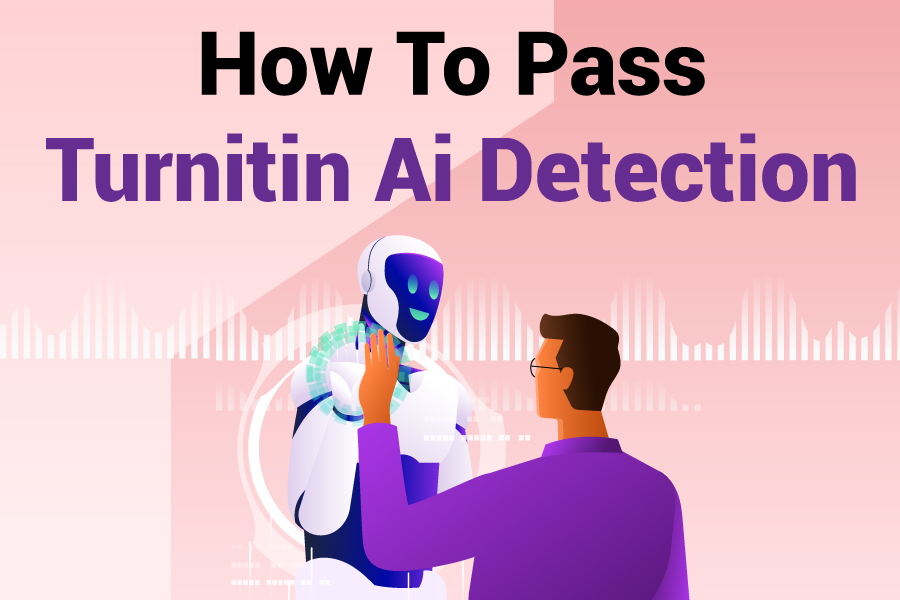In the academic world, maintaining originality is paramount. Turnitin, one of the most widely used plagiarism detection tools, has integrated AI technology to enhance its ability to detect copied content. For students and writers, understanding how to pass Turnitin AI detection is essential to ensure their work is considered original and free from plagiarism. This article will provide comprehensive strategies to help you navigate this advanced system, focusing on techniques that can help your content remain undetected. Whether you’re a student aiming for academic integrity or a writer ensuring the originality of your work, these tips will be invaluable. Let’s dive into the intricacies of Turnitin AI detection and explore how you can effectively pass its scrutiny.
How To Pass Turnitin AI Detection?
To pass Turnitin AI detection, focus on creating original content by paraphrasing effectively, citing sources properly, and utilizing plagiarism checkers before submission. These strategies help maintain the originality and integrity of your work.
Understanding Turnitin AI Detection
Turnitin’s AI detection is designed to identify not just blatant plagiarism but also subtle forms of content reuse. The system uses sophisticated algorithms to compare submitted papers against a vast database of academic works, websites, and previous submissions. By understanding how Turnitin operates, you can better prepare your content to avoid detection.
Paraphrasing is a crucial skill in this regard. Instead of copying text verbatim, rephrase ideas in your own words. This not only helps in avoiding plagiarism but also demonstrates a deeper understanding of the subject matter. Effective paraphrasing involves changing the structure of sentences, using synonyms, and ensuring that the original meaning is retained.
Proper citation is another vital aspect. Always credit the original authors of the ideas or data you use. This not only respects intellectual property rights but also adds credibility to your work. Make sure to follow the citation style required by your institution, whether it’s APA, MLA, Chicago, or any other format.
Utilizing plagiarism checkers before submission can also be beneficial. Tools like Grammarly, Copyscape, and even Turnitin’s pre-check feature can help identify potential issues. These tools provide insights into parts of your text that might be flagged and offer suggestions for improvement.
Moreover, writing from scratch is always the best approach. When you start with a blank slate and build your content around your unique perspective, the chances of encountering plagiarism issues are significantly reduced. Original research, personal insights, and critical analysis are key components of original writing.
Finally, understanding the common pitfalls that lead to plagiarism can help you avoid them. These include improper paraphrasing, forgetting to cite sources, and relying too heavily on a single reference. By being aware of these issues, you can take proactive steps to ensure your work is original and plagiarism-free.
Techniques To Pass Turnitin AI Detection
Paraphrasing Effectively
Effective paraphrasing is more than just changing a few words. It involves understanding the core idea and expressing it in a new way. This skill requires practice and a good command of the language. Tools like Thesaurus can aid in finding synonyms, but ensure the new words fit the context.
Proper Citation and Referencing
Citing sources accurately is crucial. Different academic fields have different citation styles, so familiarize yourself with the required format. Use tools like EndNote or Citation Machine to help format your references correctly.
Utilizing Plagiarism Checkers
Before submitting your work, use plagiarism checkers to identify potential issues. These tools compare your text against a large database and highlight similarities. Review the flagged sections and make necessary adjustments to ensure originality.
Writing from Scratch
Starting with a blank page encourages originality. Conduct thorough research, gather various sources, and synthesize the information to form your analysis. This approach not only avoids plagiarism but also enhances the quality of your work.
Avoiding Common Pitfalls
Be aware of common pitfalls such as improper paraphrasing, neglecting citations, and over-reliance on a single source. Regularly review your work for these issues and make corrections as needed. By being vigilant, you can ensure your content is original and free from plagiarism.
Quick Tips To Pass Turnitin AI Detection
- Paraphrase Thoroughly: Instead of copying text verbatim, rephrase ideas in your own words. Focus on changing the sentence structure and using synonyms while maintaining the original meaning.
- Cite All Sources Properly: Always give credit to the original authors of the information you use. Follow the citation style required by your institution (APA, MLA, Chicago, etc.) to ensure accuracy.
- Use Multiple Sources: Diversify your research sources. Using a variety of references reduces the risk of over-reliance on a single source and adds depth to your content.
- Utilize Plagiarism Checkers: Before submission, run your work through plagiarism detection tools like Grammarly, Copyscape, or Turnitin’s pre-check feature. These tools can help identify potential issues and provide suggestions for improvement.
- Write from Scratch: Start with a blank page and build your content based on your unique perspective and analysis. Original writing significantly reduces the chances of plagiarism.
- Incorporate Personal Insights: Add your analysis and reflections to the information you gather. This not only demonstrates your understanding but also creates unique content that is less likely to be flagged by Turnitin.
- Review and Edit Regularly: Regularly review and edit your work to catch any unintentional plagiarism. Ensure that all paraphrased content is sufficiently altered and properly cited.
Alternative Perspectives On Turnitin AI Detection
While passing Turnitin AI detection is crucial, some argue that the focus should be on learning and understanding rather than just avoiding plagiarism. This perspective emphasizes the importance of academic integrity and personal growth. By prioritizing the development of critical thinking and writing skills, students can naturally avoid plagiarism.
Moreover, some educators believe that Turnitin should be used as a learning tool rather than just a policing mechanism. By providing students with feedback on their submissions, Turnitin can help them understand their mistakes and improve their writing. This approach fosters a learning environment where students are encouraged to produce original work.
Finally, it’s important to consider the ethical implications of trying to “pass” Turnitin detection. Instead of finding ways to bypass the system, focusing on creating genuine, original content can lead to better educational outcomes and personal growth. Embracing the values of honesty and integrity in academic work not only helps in passing Turnitin but also prepares students for future challenges.
Advanced Strategies To Pass Turnitin AI Detection
- Using Synonyms and Sentence Restructuring: Incorporate synonyms and change the structure of sentences to make them look different from the source. This helps in presenting the same idea in a new light.
- Integrating Your Analysis: Add your analysis and insights to the information you gather. This not only shows your understanding but also creates unique content.
- Diversifying Sources: Use a variety of sources for your research. This reduces the risk of over-relying on a single source and introduces different perspectives into your work.
- Regular Review and Editing: Regularly review and edit your work to catch any unintentional plagiarism. This includes checking for proper citations and ensuring that paraphrased content is sufficiently altered.
Conclusion
Passing Turnitin AI detection is about more than just avoiding plagiarism; it’s about ensuring the originality and integrity of your work. By mastering the art of paraphrasing, citing sources accurately, using plagiarism checkers, and writing from scratch, you can confidently submit work that reflects your understanding and analysis. Embrace these strategies to maintain academic integrity and produce high-quality content.
FAQ’s
What Is Turnitin Ai Detection?
Turnitin AI detection is an advanced plagiarism detection tool that uses artificial intelligence to identify copied content and ensure academic integrity.
How Can I Effectively Paraphrase To Avoid Detection?
To paraphrase effectively, understand the core idea of the text, use synonyms, and restructure sentences while retaining the original meaning.
Why Is Proper Citation Important In Avoiding Plagiarism?
Proper citation gives credit to the original authors and adds credibility to your work, helping to avoid plagiarism accusations.
What Tools Can Help Me Check For Plagiarism?
Tools like Grammarly, Copyscape, and Turnitin’s pre-check feature can help identify potential plagiarism issues before submission.
Is Writing From Scratch The Best Way To Pass Turnitin?
Yes, writing from scratch ensures that your content is original and reduces the risk of plagiarism.












































Leave a Reply